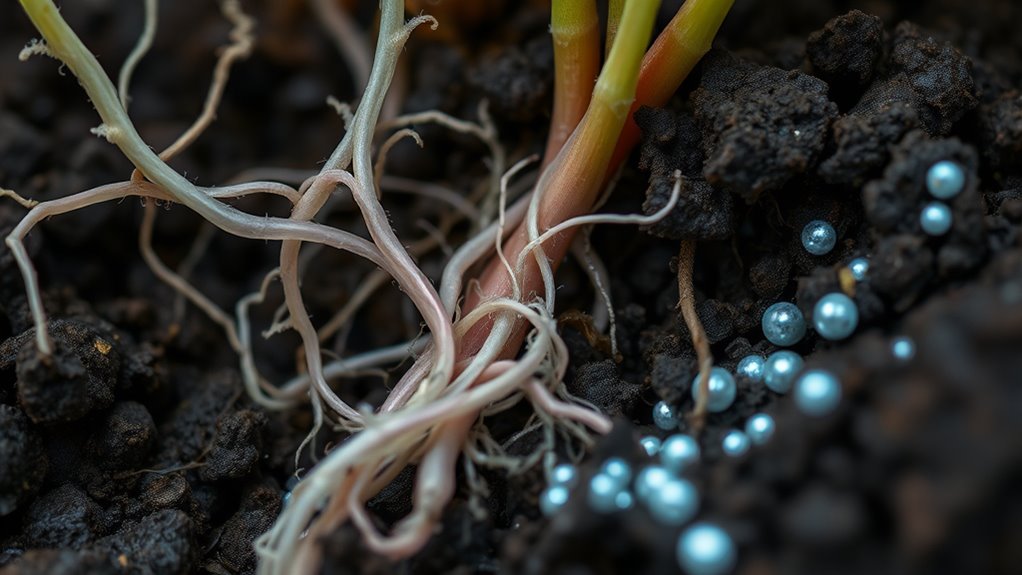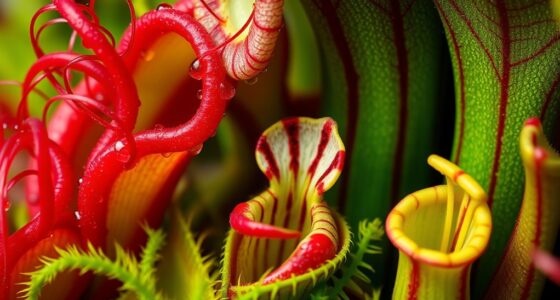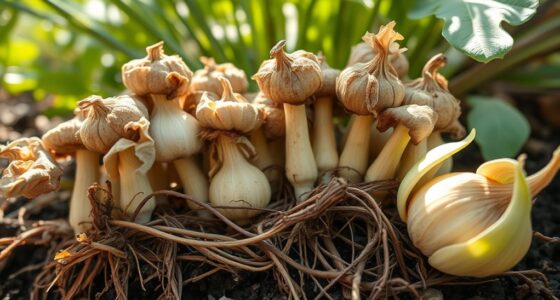In cultivating rare plants, you benefit greatly from symbiotic partners like mycorrhizal fungi and beneficial bacteria. These microorganisms form mutually helpful relationships with plant roots, enhancing nutrient uptake, especially in nutrient-poor soils. They also promote soil health by breaking down organic matter and cycling nutrients. Maintaining diverse fungal and bacterial populations, along with suitable soil conditions, boosts plant resilience. Keep exploring how these partnerships can improve your rare plant cultivation for healthier, thriving growth.
Key Takeaways
- Mycorrhizae extend plant roots, enhancing nutrient uptake, especially in nutrient-poor soils typical of rare plant habitats.
- Diverse mycorrhizal fungi and beneficial bacteria promote healthier plants and stronger symbiotic relationships.
- Maintaining balanced soil conditions—pH, organic matter, moisture—supports both fungi and bacteria for optimal growth.
- Beneficial bacteria aid in nutrient cycling and organic matter breakdown, complementing mycorrhizal functions.
- Cultivating soil with native-like microbial diversity and using inoculants fosters resilient, symbiotic partnerships for rare plants.

Many rare plants depend on symbiotic partners to thrive, making their cultivation a delicate and complex process. One of the most essential relationships involves mycorrhizal fungi, which form associations with plant roots to facilitate soil nutrient exchange. These fungi extend the plant’s root system, increasing its surface area and allowing for more efficient absorption of vital nutrients like phosphorus, nitrogen, and trace minerals. Without this partnership, many rare plants struggle to acquire the nutrients they need from the often nutrient-poor soils they naturally inhabit. By fostering healthy mycorrhizal relationships, you can substantially enhance the plant’s growth and resilience, especially in controlled cultivation environments where soil conditions might differ from their native habitats.
Fostering mycorrhizal relationships boosts rare plant growth and resilience in cultivation.
Understanding the significance of mycorrhizal diversity is key to successful cultivation. Different plants rely on specific types of mycorrhizal fungi, and the presence of a diverse fungal community can dramatically improve the plant’s health. When you cultivate rare plants, it’s important to consider the variety of mycorrhizal species present in the soil. A diverse mycorrhizal network not only boosts nutrient exchange but also provides protection against soil-borne diseases and environmental stresses. To promote this diversity, you should avoid overly sterilized soils and think about inoculating your soil with a mixture of mycorrhizal fungi tailored to the specific needs of your plant species. Such practices help mimic natural conditions and support the plant’s symbiotic relationships, leading to more vigorous growth.
Moreover, fostering soil nutrient exchange through these partnerships requires maintaining balanced soil chemistry. You need to monitor and adjust pH levels, organic matter content, and moisture to support both the fungi and bacteria involved in these symbioses. Bacteria, like mycorrhizal fungi, play a role in breaking down organic matter, releasing nutrients that plants can absorb more readily. A healthy microbial community in the soil acts as a nutrient reservoir, ensuring that your rare plant receives a steady supply of essential elements. Incorporating organic amendments, avoiding excessive chemical fertilizers, and maintaining proper watering practices help sustain this microbial ecosystem. Recognizing the importance of soil microbial diversity is fundamental to creating a thriving environment for rare plants.
In essence, cultivating rare plants successfully hinges on nurturing the complex web of soil nutrient exchange facilitated by diverse mycorrhizal fungi and beneficial bacteria. By understanding and supporting these natural partnerships, you’re creating an environment that mimics their native ecosystems, giving your plants the best chance to flourish. This approach requires patience and attention to soil health, but the rewards are healthy, resilient plants that thrive because they’re working in harmony with their unseen partners underground.
Frequently Asked Questions
How Do Mycorrhizae Affect Plant Nutrient Uptake?
You might wonder how mycorrhizae impact plant nutrient uptake. They colonize your plant roots, boosting nutrient exchange by expanding root surface area. This root colonization allows mycorrhizae to efficiently transfer essential nutrients like phosphorus and nitrogen from the soil to your plant. As a result, your plant grows healthier, stronger, and more resilient because it benefits from improved access to crucial nutrients through this symbiotic relationship.
Can Bacteria Enhance Rare Plant Resistance to Pests?
You can boost your rare plant’s pest resistance through bacteria by leveraging biological pest control strategies. Certain bacteria enhance the plant’s natural defenses, making pests less likely to attack. Effective microbial community management guarantees these beneficial bacteria thrive, creating a protective environment. By integrating these practices, you can reduce reliance on chemical pesticides, promote plant health, and foster a resilient ecosystem that naturally deters pests.
Are There Specific Bacterial Strains Best for Certain Plants?
Did you know that over 90% of plant species form beneficial microbial relationships? When choosing bacterial strains for your plants, microbial specificity and plant microbe compatibility matter. Not all bacteria work equally well with every plant, so selecting the right strains boosts growth and resilience. You should research which bacteria are best suited for your specific plants to guarantee strong, healthy growth and maximize their potential.
How Do Symbiotic Relationships Develop Over Time?
You develop symbiotic relationships over time as soil health improves and microbial diversity increases. When you provide ideal conditions, beneficial microbes like mycorrhizae and bacteria thrive, forming connections with plant roots. These partnerships enhance nutrient exchange and resilience. As your soil environment becomes richer and more balanced, these symbiotic relationships strengthen naturally, supporting healthy plant growth and long-term sustainability.
What Are the Risks of Introducing Non-Native Microbes?
Oh, the thrill of introducing non-native microbes—what could possibly go wrong? You risk disrupting the delicate ecological balance, inviting microbial competition that may outcompete native beneficial partners. It’s like inviting overzealous guests to a quiet dinner—things get chaotic fast. These foreign microbes could dominate, harm your rare plants, or even jump to other species, causing unintended ecological chaos. Better to tread carefully and respect nature’s microbial harmony.
Conclusion
As you nurture rare plants, imagine their roots weaving a silent dance with mycorrhizae and bacteria beneath the soil’s surface. These tiny partners form an intricate network, like a hidden symphony of life, helping your plants thrive in the shadows. By embracing these natural alliances, you uncover vibrant growth and resilience. So, tend to the soil with care, and watch as your rare plants flourish, their roots whispering secrets of symbiosis beneath your fingertips.










